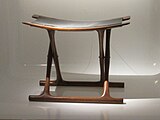About this product
Ole Wanscher (16 September 1903 – 27 December 1985) was a Danish furniture designer. He was one of the leading figures in the Scandinavian Design movement (a part of Mid-Century Modernism), at a time when Scandinavian Design achieved worldwide popularity.
Early life and education
Wanscher was born on 16 September 1903 in Frederiksberg, Copenhagen, the son of art historian Vilhelm Wanscher (1875-1961) and painter Laura K. Baagøe Zeuthen (1877-1974). He studied at the Danish School of Art and Design, and was particularly influenced by Prof. Kaare Klint.[1]
Design career
Windsor chair, 1942, Danish Design Museum, Copenhagen
Folding stool, 1957, Danish Design Museum, Copenhagen
After completing his studies, Wanscher worked with Klint from 1924 to 1927, at which time he set up his own office, specializing in furniture design.
Throughout the 1930s and 1940s, Wanscher, working with master joiner A. J. Iversen, produced dozens of designs that are now seen as modern classics. In the 1950s, Wanscher left his private firm and began an association with P. Jeppesens Møbelfabrik A/S that would last for the rest of his professional life.
Like his mentor Kaare Klint, Wanscher was influenced by a variety of sources, from 18th century British design through the furniture design of Ancient Egypt. One of Wanscher’s most famous pieces was his so-called “Egyptian Stool” of 1960. He was also influenced by Greek and Chinese design.
While many of Wanscher best known designs were built with master joiner A.J. Iversen, Wanscher also showed a particular interest in the mass production of furniture, and several of his pieces were designed with mass production in mind. One of Wanscher’s best known designs is the teak easy chair designed for France & Son in 1951.
Read more.


















